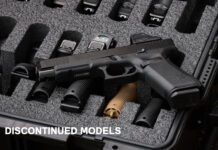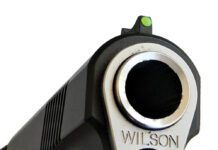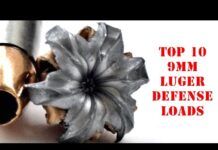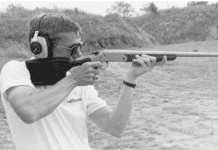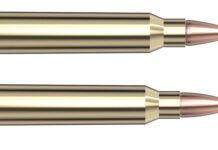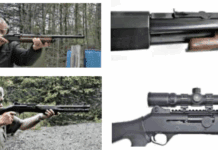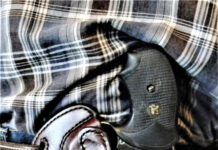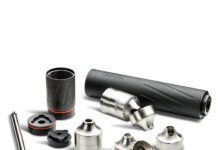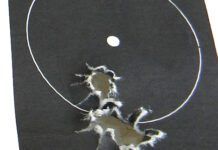In February, we began evaluating tactical or military-style carbines chambered for the 22 LR round, and we continue to find new guns in what we call the “rim-tac” category. Previously, we looked at one AR-15 derivative, one tac-styled 10/22, and another carbine that more closely resembled a 1941 Russian machine gun. Our test guns were the Ruger SR-22R No. 1226 22 LR, $625; Smith & Wesson’s M&P 15-22 No. 811030 22 LR, $569; and the Legacy Sports Puma Wildcat PPS2250S 22 LR, $550. In that test, we narrowly liked the Smith & Wesson M&P 15-22 the best, giving it an A grade compared to the Ruger’s A- tally and the Wildcat’s Bgrade.
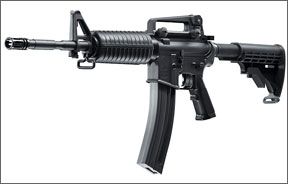
Along the way, we had a heckuva lot of fun with the rifles without breaking the ammo bank. So, we gathered up two more rimfire samples from Umarex and Sig Sauer and wheelbarrowed bricks of 22 fodder to the range and had at it. Our test guns this round were the very different Colt M4 Carbine No. 2245050 22 LR, $576; and the Sig Sauer Sig522 Classic No. SIG522001 22 LR, $572.
The Colt has a complicated background. Carl Walther Germany entered into a licensing agreement with New Colt Holding Corporation, in which Carl Walther will produce these 22 rifles in Germany under the Colt brand. Umarex USA is responsible for importation, sales, marketing and service for the Colt tactical replicas.
Two tactical styles are being offered, each modeled after a Colt original—the M4 and M16 rifles—and both are available in two variations with 30-round 22 LR magazines along with a variety of accessories. The M4 version that we tested is a blowback semiauto with a barrel length of 16.2 inches (412 mm), overall length of 31.1 to 34.4 inches depending on the adjustable stock length, and iron sights, with the rear set into a detachable carry handle on a metal flat-top receiver.
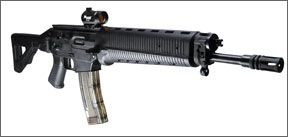
Likewise, the Sig522 has lineage worth noting. According to Sig Sauer, the 522 has the “…look and feel of the Classic SIG556. Featuring SIG556 parts, including a Swiss-type folding stock and polymer forend on a durable metal receiver with integral Picatinny rail.” We evaluated a 556 in the March 2010 issue, grading the 5.56mm rifle highly with an A-, but dinging it for its weight and cost.
Those aren’t such factors with the 522, whose price tag is a few dollars below the M4 rimfire and whose weight is 6.4 pounds empty. Its overall length is 35.1 inches with the stock fully extended, 33.6 inches with the stock collapsed, and 26.1 inches with the stock folded.
How We Tested
First, we broke the guns down and cleaned, inspected, and lubed them according to the directions in their respective manuals. The Colt was easier to break down, in our view, simply because we were more familiar with that design. The Sig didn’t offer any problems in that area, except the learning curve.
In the initial run through, we fired a mixture of 500 rounds of three ammos in each gun, noting cycling or feeding problems. We had two failures to fire (the firing pin didn’t hit the Wolf rim) in the Sig, and we had two light firing-pin strikes with the Colt when we fed it CCI Green Tag. We didn’t see a need to adjust the bolt speed to compensate for different ammunition velocities, but we kept an eye out in case problems developed later. Colt recommends using only high-velocity ammo, but our standard-speed choices seemed to work fine, so we forged ahead.

Our test rounds were the Remington Golden Bullet brass-plated 36-gr. hollowpoint ($18.99/525), CCI’s Green Tag 40-gr. solid lead roundnose ($15.29/100), and Wolf Match Extra 40-gr. lead roundnose ($71.99/500) We bought the rounds from Midway USA. We used a CED M2 chronograph to record velocities, and for the first round of accuracy testing at 50 yards, we shot the guns off a Bench Master rifle rest using two sets of sights. On the 522, we used a Sig Mini Red Dot Sight STS-081, $215. On the Colt, we used the supplied iron sights. For the second round, we chose each gun’s best ammo from the first round, then fitted an RWS 3-9×44 Night Pro Illuminated MilDot Reticle scope onto the guns’ rails with Weaver 30mm High Rings and shot more groups onto Birchwood Casey fluorescent-orange 6-inch Target Spots. To tabulate the results, we scanned the targets and used the Ruler tool inside Photoshop CS3 to measure the groups.
Accuracy Results
In this test, rather than shooting groups, we used the accuracy measurement of Average Group Radius. To calculate AGR, we found the center of a 10-shot string and averaged the distances from the statistical group center to each shot. Using this system, each shot becomes its own data point, which increases the sample size, which improves the statistical significance of the data. We also reported Maximum Shot Radius, the distance from a group’s statistical center to the center of the most distant hole—basically quantifying the worst shot in the string. Also, we noted each ammo’s Maximum Spread (group diameter) for the 10-shot strings.
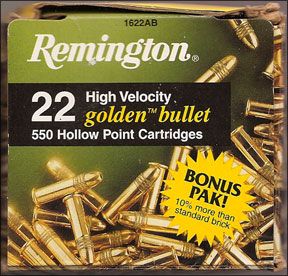
Using the Remington Golden Bullet, the Sig Sauer/Mini Red Dot combo narrowly fell behind the Colt M4 and its iron sights, shooting a larger average group radius of 0.75 in. to 0.65 in. for the Colt. The Colt shot this round even better with a scope, lowering its average group radius for 10 shots down to 0.60 in.
With CCI Green Tag, the Sig came roaring back with a tiny average group radius of 0.43 in. to the Colt’s 0.94 in. Perhaps more amazing was that the Mini Red Dot sight outdid the scope results for the Sig, an average group radius of 0.54 in. With the Wolf Match Extra, the Sig likewise held a decided edge, shooting groups about half the size of the Colt, 0.42 in. to 0.87 in.
Colt M4 Carbine No. 2245050 22 LR, $576
The Colt 22 Tactical M4 is available as a standard carbine, which is our test gun, and an OPS version. At the rear of the M4 is a 4-position buttstock. The OPS version is outfitted with a CNC-machined rail interface system and a detachable tactical rear sight. The new Colt 22 Tactical Rimfire M16 is a replica of Colt’s M16A4. The SPR version (Special Purpose Rifle) furthers the M16’s tactical appearance with the addition of flip-up front and rear sights along with a rail system. All versions are made in Germany with metal bodies, flat-top receivers, cartridge-case deflectors for left-handed shooting, and muzzle compensators. All are semiautomatics with step-cut 6-groove rifled barrels.
The M4’s overall length ranges from 31.1 to 34.4 in., depending on how far the telescoping stock is extended. The barrel is 16.2 inches long with a 1:13.75-inch twist. With the detachable carry handle and rear sight snapped on the Mil-Spec flattop receiver, the sight radius is 14.8 inches. The gun is a tall 9.1 inches in overall height without the 30-round magazine in place, and 13 inches tall with the mag installed. Without the magazine, the gun’s heft is 6.0 pounds; a fully loaded 30-round mag adds another 1.3 pounds to the overall weight.
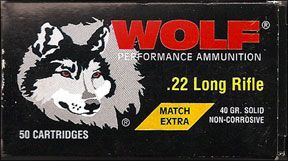
As we noted above, the Colt shot the best with one ammo, and in our view, surprisingly well with its iron sights. To shoot the initial 50-yard groups, we put the 2mm front post at 6 o’clock under the target, and used the 0.06-inch-diameter rear sight aperture rather than the CQB-size 0.2-inch aperture. The sight picture on a cloudy, nearly windless day was fuzzy, but crisp enough to be repeatable. Our team said the biggest issue in shooting the Colt better was likely its single-stage 9.0-pound trigger-pull weight. It was very heavy, though there wasn’t any creep or overtravel.
Elsewhere on the gun, we noted the dust cover didn’t function. Umarex says this is an intentional engineering design so that with the dust cover open and the bolt exposed with the empty chamber indicator (blue tab) inserted, it is easier to quickly determine if the rifle is unloaded. In addition, when the rifle is stored, it should be stored with the bolt closed and the empty chamber indicator in place, making a dust cover unnecessary since the chamber is protected from dust and debris.
Also, the forward assist doesn’t work—it’s there to maintain the Colt “look.” If the assist were to work, it could cause a jammed rimfire cartridge to fire when struck. Similarly, the external bolt catch doesn’t work—it’s there to maintain the authentic look. Functionally, the rifle uses an internal bolt lock, which worked fine.
And there are five dummy pins in the receiver, three on the left and two on the right. The only active pin is the rearmost, which allows the receiver to open. The other three are there to maintain the visual identity of the M4.
Further, there are internal variations between the 5.56 M4 and the 22 LR M4, besides the obvious chambering differences. For example, standard AR replacement grips will not work on these rifles because their internal hole(s) do not line up with the screw mount. Also, the buffer tube can’t be exchanged, but the multi-position buttstock can be replaced.
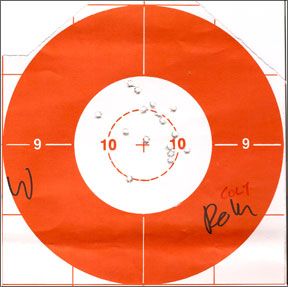
Initially, our team shooters had difficulty getting the (single) magazine to seat properly—it required a little oomph. As the test went on, the insertion became easier. We agreed that the Colt magazine, with grooved tabs on both sides, was much easier to load to capacity than the Sig’s 25-round unit. However, the shooter has to avoid allowing the front of the magazine to tip too far downward, or rounds will fall out. The Sig’s design didn’t have that problem.
Elsewhere, we noted how tight the receiver fit was, in particular, the rear pin fit was very tight. The manual warns to loosen the compensator (flash suppressor) two turns before removing the rear pin. This takes pressure off the pin and makes it easier to remove. A wrench is provided.
Compared to the GT Grade A Smith & Wesson M&P 15-22, the Colt lacked Picatinny rails on all four sides of the handguard, using instead the standard M4 polymer handguard. (The OPS version has a full rail package.) In contrast, the Sig’s polymer fore end had three spots onto which optional handguard rails could easily be added.
However, Smith & Wesson did leave off the flash hider, and the trigger guard was molded, sans bottom hinge, as one piece with the polymer receiver. The Colt kept the flash hider, and the trigger guard was the hinged metal type true to the M4 style.
The right-hand side of the Colt carbine kept the dimensionally correct ejection port of the centerfire model, but about three-quarters of an inch of the barrel appeared in the port. The bolt was worked by the charging handle, and we had no operational malfunctions.
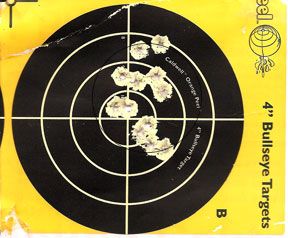
The magazine was the approximate size of a 30-rounder, but if we bought the gun, we’d consider getting at least one 10-round magazine ($29.37, No. 2245100) for bench shooting. Maneuvering the 30-rounder, even on a raised benchrest, is tricky because of the height of the gun, 13 inches. Off sandbags, it would be nearly impossible to shoot with the long mag installed. As it was, we had to cant the rifle slightly on the benchrest to clear the shooting table.
Owners of the Colt will get a genuine feeling of shooting an AR-15. Included are four-position adjustable buttstock with solid mount sling loop. The magazine release was right-side only, index-finger operated. The safety was above the grip on the left side. Safety-on was parallel to the bore. The gun was ready to fire when the lever was pointing backward. Unlike on the S&W, the bolt release on the left side was nonfunctional.
No other semiautomatic rifle or carbine breaks down as easily as an AR-15, and the Colt was field-stripped in the same manner. Push inward on the pin located on the left side of the receiver immediately above the grip, and the top end hinged away from the receiver. The bolt and carrier were then pulled out by the charging handle, which separated as the carrier leaves its channel.
The receiver was a flat-top style, with 5 functional inches of rail. The front sight was the tower style with a square blade that was adjustable for height by depressing the spring-loaded detent peg and turning the blade. The rear sight was adjustable for windage and elevation, and two apertures of different size could be rotated into place, just like an AR-15 sight. In handling, the Colt was nimble and pointed well, our team said.
As we noted above, the Sig outshot the Colt with two of the three test ammos. Compared to the S&W with the Green Tag ammo common to both tests, the Colt and M&P15-22 were neck and neck in accuracy. The M&P shot 0.9-inch groups at 50 yards with the CCIs, and the Colt’s AGR was 0.94 inches.
Our Team Said: A straight-up comparison between the Colt and the S&W M&P15-22 we tested isn’t quite fair, since the S&W had full-length rails and other options more comparable to the Colt OPS model. However, the Colt covers all the bases in duplicating the AR-15 experience, though incorporating so many nonfunctional “look” features (pins, bolt release, dust cover) gave us pause. Compared heads-up with Sig, the Colt is the hands-down winner if what you’re looking for is an AR experience with a rimfire. The Colt is certainly a quality gun, but its trigger-pull weight was a huge drawback—simply too heavy. For now, we have to recommend the S&W over the Colt if you want the AR-15 experience in 22 LR, and we have to pick the Sig Sauer over the Colt if you want a tactical rimfire without regard to the AR-15 controls.
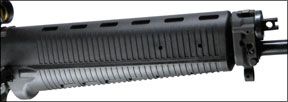
Sig Sauer Sig522 Classic No. SIG522001 22 LR, $572
Introduced in 2009, the Classic is one of two current offerings in the 522 line. In most respects, the Classic is a direct competitor to the Colt reviewed above, considering the 522’s polymer furniture. The 522 SWAT No. R522-16B-CS competes more directly with the S&W M&P15-22, with both guns having quad rails instead of polymer handguards. The SWAT lists for $686.
Current retail sales prices seem to run about $475 for the gun, which will come with one magazine (capacity determined by your state of residence), a blue-plastic gun case, gun lock, and interchangeable buttplates.
Like its 556 big brother, the 522s include a Swiss-type folding stock and polymer fore end on an aluminum-alloy upper receiver and lower polymer receiver. In most measurements, the 522 and M4 Rimfire compare favorably. The 522 has an overall length range of 33.6 to 35.1 inches with the stock locked open. The 522 gains a significant advantage with its stock folded, measuring only 26.1 inches in OAL. And yes, all the controls still work with the stock folded, and the gun can be comfortably point-shot from a low position using the pistol grip. With an Insight M6X laser aboard, it can be shot reasonably accurately from the low folded position. The 522 has a rear sling loop on the receiver above the stock hinge as well as a molded-in loop in the buttstock.
The 522’s barrel is 16.6 inches long with a 1:16 inch twist, slightly slower than the Colt. There’s a little more sight radius, 18.1 inches for the 522 to 14.8 inches for the Colt, but that’s not much of a factor, our testers said. The Colt got huge points from our team, however, because it came with sights in its detachable handle. We added a $215 Sig Mini Red Dot Sight to shoot the 522, which would bring its roll-out price to a hefty $787. We could have chosen Sig’s optional folding sight set, $245. The rotary diopter rear sight provides four stations (CQB, 100m, 200m, 300m) with tool-less windage and elevation adjustment. This sight attaches to the receiver M1913 rail and is designed to work in conjunction with a hooded front sight. But it’s somewhat overkill since it’s optimized for M855 and M193 ammunition. The front and rear sight co-witness with the Mini Red Dot Sight.
Elsewhere on the 522, it’s tall, but not quite as tall as the Colt, measuring an overall height of 8.9 inches without a mag (but with the Mini Red Dot sight) and 11.2 inches tall with the mag and sight. The 522 weighs 6.3 pounds without a magazine in place, and more usefully, it goes 7.1 pounds with a fully loaded magazine (25 rounds), slightly less than the 30 rounds in the Colt that bring the ready-gun weight to 7.3 pounds. Call that a coin flip.
Magazines come in 10- and 25-round counts, and we’d renew our suggestion that if you buy the 522, get one shorter magazine for bench work. We found the Colt is worse off the bench because it’s taller overall. As we noted, the Colt mag was much easier to load.
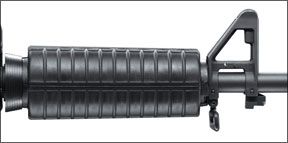
The flat-top 522 receiver was made of 7075-T6 aircraft-grade aluminum with a hard-coat anodized finish, and, like the Colt, it housed a blowback semiauto action. All the stocks are polymer, and the shape of the Swiss-style fore end is more vertical than the rounded handguard on the Colt. We liked the 522’s shape better because it allowed a standing hold between the thumb and first finger, or between the first and second fingers.
Another area in which the 522 gained an edge was its trigger pull. Admittedly, the trigger was spongy and indistinct, with about a quarter-inch of creep before the sear released. But, with practice, we learned to stage the frontward movement and find the 5.8-pound release at the back of the pull, with great results, as we documented above. The bottom line was that the Sig shot twice as accurately as the Colt with two of the three test ammos. Lefties noted that the gun didn’t throw shells into their faces.
And, oddly, the 522 is easier to minmally customize than the Colt M4. There are three attachment points to add handguard rails on the fore end. The rail package costs $20.
We agree with Sig Sauer’s marketing push that the 522 handles like the full-size centerfire 556. There are some weight and balance differences, but if you already own a 556, then buying the 522 is a no-brainer if you want a rimfire to shoot that will save money.
Our Team Said: Here are the major drawbacks to the 522. It’s not an AR-15 styled product, so if that’s what you want, look elsewhere. It doesn’t come with a sight, so you’ll have to budget for a Mini Red Dot (which we recommend), spend money elsewhere for Mil-Spec-mount open sights, or add other optics. Accordingly, the 522 comes in hundreds of dollars more expensive than the Smith AR15-22 or the Colt M4, and that’s a big issue for someone searching for a fun rimfire to shoot. But is the 522 worth its premium price? We think that it is.
0510-colt-m4-carbine-2245050.pdf



